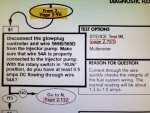NCarolinadawg
New member
- 27
- 7
- 3
- Location
- North Carolina
Hello, 1989 M998 6.2 a few days now seems to crank/idle/run fine for about 10 minutes but then starts to surge and sputters and will eventually shut off. Will only then restart after cranking about 15 to 20 seconds but will then immediately die again. Will not restart. Come out in Morning, same thing, runs fine, then acts up as above. Fuel line to filter seems to pump fine into a bottle, pumps like the old lever handle water pumps, not a solid stream, but I assume that's correct. Replaced fuel filter and separator, cleaned housing, started just fine amd purged air with screw on housing, them Same scenario as above repeated with issue. Just don't understand how runs so well then issue.


